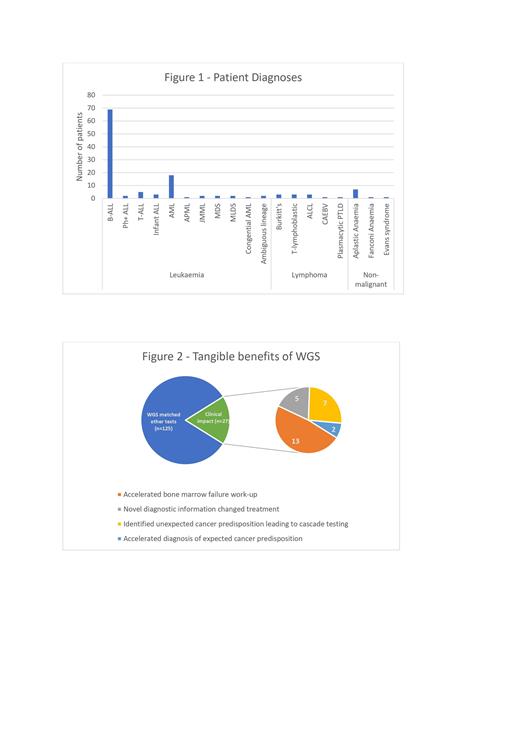Background
There is emerging evidence that whole genome sequencing (WGS) can benefit children with hematological malignancies, even when compared to extensive molecular assays. However, studies have been restricted to selected patient groups, and so there is a need to evaluate the feasibility and impact of WGS delivered as part of children's routine care. In England, following the 100k genome project, since early 2021 paired germline and tumor WGS has been made available to all children with a suspected malignancy via the nationalized Genomic Medicine Service. We set out to assess the real world impact of routine WGS, where sequential unselected children were sequenced, and results were used in clinical practice.
Methods
Clinical and diagnostic information was collected from all patients presenting to Great Ormond Street Hospital (GOSH) hematology department over a 2-year period. WGS findings were superimposed onto the center's standard of care (SOC) and WGS impact was evaluated.
Results
Between 1 January 2021 and 31 December 2022, 152 children with new diagnoses or relapsed disease had paired WGS, with an uptake rate of 83% (76/92) in the first year and (79/83) 95% in the second. Barriers to recruitment were clinicians not offering WGS (n=16) in year 1, and early death (n=2) or parents declining consent (n=2) in year 2. WGS was performed for all 20 diseases that were treated (Figure 1).
Importantly, WGS matched all SOC findings by other genetic tests, including targeted DNA high throughput sequencing (HTS) and RNA-fusion panels. WGS revealed additional oncogenic drivers in 79/152 (52%) of patients, compared to all other genomic tests (including HTS and RNA-fusion panels). WGS aided diagnosis in 11% (17/152) of cases through picking up a novel lesion that defined the child's malignancy, and for 7% (10/152) of patients, it was able to place them into a new formal cytogenetic risk category.
In 25/152 (17%) cases care was changed solely because of WGS (Figure 2), with a similar rate in year 1 (14%) and 2 (17%). In 3 cases of B-acute lymphoblastic leukemia (B-ALL) diagnostic testing failed to reveal a risk-defining lesion but WGS identified good risk variants (ETV6-RUNX1 and High Hyperdiploidy) allowing de-escalation of chemotherapy. IGH-DUX4 re-arrangements, solely picked up by WGS in 2 cases of B-ALL, led to 1 child not receiving escalated chemotherapy. In a child presenting with mixed phenotype leukemia, WGS alone revealed a KMT2A-USP2 fusion, which directed therapy, as well as providing an MRD marker.
In 12 patients presenting with marrow failure (subsequently diagnosed with aplastic anemia or MDS), WGS was prioritized with a median turnaround time of 2 weeks. WGS was able to give an accelerated diagnosis, facilitating timely therapy.
9 children were found to have pathogenic germline variants. This included 2 cases of an accelerated diagnosis of expected mutations (e.g. an SBDS mutation). Other unexpected germline mutations (e.g. a TP53 mutation presenting with leukemia, and an incidental PMS2 mutation in the context of aplastic anemia), led to cascade testing for patients and their families, and tailored surveillance programs.
WGS made 9 children eligible for novel therapeutics, including patients found to have a RAS pathway mutation solely by WGS, and patients who were hypermutated.
Conclusion
WGS can successfully be delivered as a nationalized genomics medicine service, for all children with suspected hematological malignancies. WGS can match conventional and advanced genomic diagnostics in a single assay, with obvious economic benefits of test consolidation. Beyond this, it delivers additional germline and somatic findings that aid diagnosis, offer therapeutic opportunities, and tangibly change the care patients and families receive. WGS has the additional benefit of future proofing diagnostic and research capabilities, as over time analysis pipelines can be modified and new variants added.
For all children presenting with marrow failure, WGS was practice changing, providing all necessary read-outs, and facilitating timely therapy. In the case of the most common childhood malignancy, ALL, one test can replace all diagnostics, including IG/TCR MRD marker screening and pharmacogenomics for TPMT/NUDT15.
With continued improvements in turnaround time, and reducing costs, we propose that WGS could feasibly replace multiple molecular diagnostic tests for pediatric hematological malignancies.
Disclosures
Ghorashian:Novartis: Honoraria, Speakers Bureau; UCLB: Patents & Royalties. Rao:Sobi: Consultancy. Samarasinghe:Pfizer: Honoraria; Jazz Pharmaceuticals: Honoraria.


This feature is available to Subscribers Only
Sign In or Create an Account Close Modal